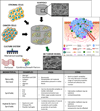Modeling tumor microenvironments using custom-designed biomaterial scaffolds
- PMID: 27152253
- PMCID: PMC4852888
- DOI: 10.1016/j.coche.2016.01.012
Modeling tumor microenvironments using custom-designed biomaterial scaffolds
Abstract
The dominant roles of the tumor microenvironment in regulating tumor formation, progression, and metastasis have driven the application of tissue engineering strategies in cancer biology. Highly dynamic and reciprocal communication of tumor cells with their surroundings suggests that studying cancer in custom-designed biomaterial scaffolds may lead to novel therapeutic targets and therapeutic regimens more reliably than traditional monolayer tissue culture models. As tissue engineering becomes progressively more successful in recapitulating the native tumor environment, critical insights into mechanisms of tumor resistance may be elucidated, to impact clinical practice, drug development, and biological research. We review here the recent developments in the use of custom-designed biomaterial scaffolds for modeling human tumors.
Keywords: Biomaterials; cancer; scaffold; tissue engineering; tumor models.
Figures




References
-
- Siegel RL, Miller KD, Jemal A. Cancer statistics, 2015. CA: Cancer J Clin. 2015;65:5–29. - PubMed
Grants and funding
LinkOut - more resources
Full Text Sources
Other Literature Sources
Research Materials
